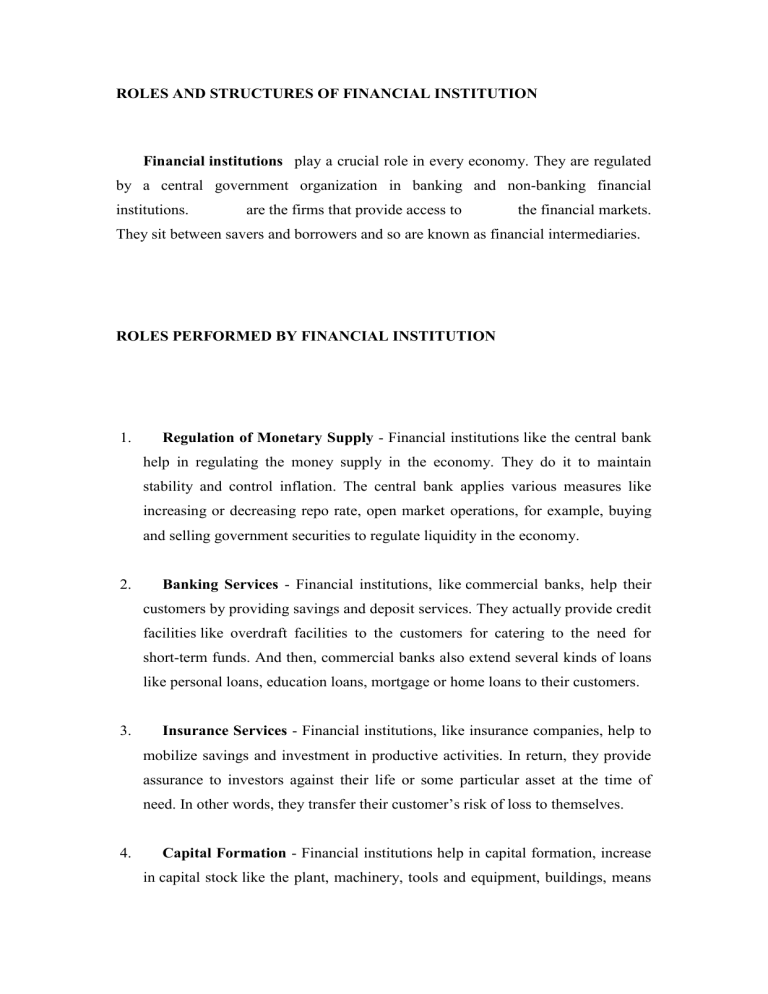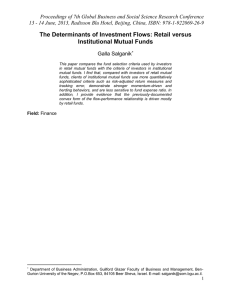
ROLES AND STRUCTURES OF FINANCIAL INSTITUTION Financial institutions play a crucial role in every economy. They are regulated by a central government organization in banking and non-banking financial institutions. are the firms that provide access to the financial markets. They sit between savers and borrowers and so are known as financial intermediaries. ROLES PERFORMED BY FINANCIAL INSTITUTION 1. Regulation of Monetary Supply - Financial institutions like the central bank help in regulating the money supply in the economy. They do it to maintain stability and control inflation. The central bank applies various measures like increasing or decreasing repo rate, open market operations, for example, buying and selling government securities to regulate liquidity in the economy. 2. Banking Services - Financial institutions, like commercial banks, help their customers by providing savings and deposit services. They actually provide credit facilities like overdraft facilities to the customers for catering to the need for short-term funds. And then, commercial banks also extend several kinds of loans like personal loans, education loans, mortgage or home loans to their customers. 3. Insurance Services - Financial institutions, like insurance companies, help to mobilize savings and investment in productive activities. In return, they provide assurance to investors against their life or some particular asset at the time of need. In other words, they transfer their customer’s risk of loss to themselves. 4. Capital Formation - Financial institutions help in capital formation, increase in capital stock like the plant, machinery, tools and equipment, buildings, means of transport and communication. They do so by mobilizing the idle savings from individuals in the economy to the investor through various monetary services. 5. Investment Advice - Investment advice is any recommendation or guidance that attempts to educate, inform, or guide an investor regarding a particular investment product or series of products. There are a number of investment options available at the disposal of individuals as well as businesses. But in the current swift changing environment, it is very difficult to choose the best option. Almost all financial institutions (banking or non-banking) have an investment advisory desk that helps customers, investors, businesses to choose the best investment option available in the market according to their risk appetite and other factors. 6. Pension Fund Services - Financial institutions, through their various kinds of investment plans, help the individual in planning their retirement. One such investment options is a pension fund, where the individual contributes to the pool of investment set up by employers, banks, or other organizations and get the lump sum or monthly income after retirement. 7. Trust Fund Services - Some financial organization provides trust fund services to their clients. They manage the client’s assets, invest them in the best option available in the market, and take care of its safekeeping as well. 8. Act as A Government Agent for Economic Growth - Financial institutions are regulated by the government on a national level. They act as a government agent and help in the growth of the nation’s economy as a whole. For example, to help out an ailing sector, financial institutions, as per the guidelines from the government, issue selective credit line with lower interest rates to help the sector overcome the issues it is facing. STRUCTURE OF FINANCIAL INSTITUTION Financial institutions serve as financial intermediaries between savers and borrowers and direct the flow of funds between the two groups. Some aspects of a financial institution's organizational structure are determined by the national laws under which the institution operates. Those that accept deposits from customers—depository institutions—include commercial banks, savings banks, and credit unions; those that don’t—non depository institutions—include finance companies, insurance companies, and brokerage firms. Financial institutions offer a wide range of services, including checking and savings accounts, ATM services, and credit and debit cards. They also sell securities and provide financial advice. A bank holds onto only a fraction of the money that it takes in—an amount called its reserves—and lends the rest out to individuals, businesses, and governments. In turn, borrowers put some of these funds back into the banking system, where they become available to other borrowers. Mutual funds are financial intermediaries set up by organizations. Mutual fund companies are able to spread research, commissions, and related expenses over a larger asset base, which reduces the cost for individual fund investors. Private Sector Mutual Funds: Private mutual funds are an exclusive investment with a limited number of investors. The minimal investment for a share of a private mutual fund is much higher than that of a public mutual fund. Public Sector Mutual Funds: Public mutual funds, as their name suggests, are open to the public to invest in. They are managed by professional fund managers, who actively invest in various securities to achieve the mutual funds’ stated objectives, which could be capital growth or income. SSS is a social insurance program that aims to provide protection to its members and beneficiaries, while GSIS serves as the counterpart social insurance program for those who work in government. SSS members can avail of maternity, sickness, disability, retirement, funeral and death benefits. All Borrowers shall be covered by a Group Credit Life Insurance (GCLI) which is a special form of group term insurance that is issued to a creditor (SSS) that provides full coverage for the loan principal of the Borrower. FINANCIAL INSTITUTIONS PHILIPPINES The Bangko Sentral BSP IN THE ng Pilipinas (BSP) is the central bank NONBANK BANK GOVERNMEN T DBP Landbank of the GOVERNMENT PRIVATE Commercial Bank SSS Insurance Bank Savings Bank GSIS Lending Company Rural Bank PAGIBIG Pawnshop Universal Bank PHILHealth Remittance PRIVATE Republic of the Philippines. REFERENCES: https://www.coursehero.com/file/76735284/Structure-of-financial-institutions-and-ca pital-Marketsdocx/ https://www.investopedia.com/terms/f/financialintermediary.asp https://www.wallstreetmojo.com/role-of-financial-institutions/ https://bizfluent.com/list-6748849-types-international-banking.html Principles-of-Managerial-Finance-13th-Lawrence-G.-Gitman-1.pdf






